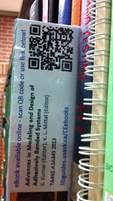| URLs in this document have been updated. Links enclosed in {curly brackets} have been changed. If a replacement link was located, the new URL was added and the link is active; if a new site could not be identified, the broken link was removed. |
Tips from the Experts
E-Resource Discovery: A Collection Development Strategy for Engineering E-books
Science Liaison Librarian
Engineering Library
University of Saskatchewan
Saskatoon, Saskatchewan
tasha.maddison@usask.ca
The University of Saskatchewan Library subscribes to many online providers of e-book collections. Some of the main engineering collections include CRCnetBASE, Access Engineering, Wiley Online Library, Springer Link, and Science Direct. From a collection development perspective, the purchase of e-books is complicated by two main factors. First, print notification slips are typically available in advance of e-book slips, which may result in multiple copies of an item being owned in different formats. Second, the metadata for these collections typically is provided to the library in bulk packages which takes time to be processed and for the individual records to be made available to library users in the catalogue.
In order to avoid duplicate items as well as purchasing e-books from non-preferred platforms, I developed a strategy to address both of these challenges from an acquisitions perspective as well as to ensure that items are discoverable by library users as quickly as possible.
I receive separate notification slips electronically for each engineering discipline on a weekly basis from our book acquisitions and collection development service provider. I start by analyzing each desirable slip, concentrating on the publisher of that particular item. If the item is published by one of our currently held e-book providers, I search for the title of the book within their database. If we already own the title, I record the title, author, database and the call number (which is available on the notification slips) into a spreadsheet, using the call number to select the most appropriate engineering discipline that this item falls under. Each discipline has its own page within the spreadsheet in order to organize items more efficiently.
Once a previously purchased item is noted, I also use the information above to manually populate a new e-books tab on each of my discipline specific library guides. Each record includes the cover art as well as a direct link to the title in its respective database. For an example, please refer to: {http://libguides.usask.ca/CEeBooks}. Once library users have signed in with their university credentials, they can click on the title of the item to link directly to the contents from their tablet, computer, or mobile device.
To assist individuals browsing the physical stacks, library assistants create markers that are placed at the approximate call number location where the e-book would fall. The markers include the title, author, and the call number of the e-book, along with a QR code that will link the individual to the item in the library guide or the URL for the library guide (for those individuals who do not have access to a smart device). One limitation that affects how our library users access information is the fact that our mobile library web page defaults to the library's home page, despite the fact that a QR code is set up to link to a specific web page. To circumvent this issue, individuals are linked to the "New e-books" tab on the library guide instead of directly to the e-book itself which is not affected by the same limitation.



Markers are attached to sturdy card paper and then inserted in the appropriate location; clearly visible to patrons who are browsing the stacks. Please note that the QR code is vertically aligned to allow individuals to snap a picture of it from the correct angle.
If the item is not currently owned by the library or part of one of the e-book collections from the publishers noted above, then I create a separate list for consideration towards the end of the fiscal year. If possible, individual e-books would be purchased in bulk from individual publishers. Bulk purchases have the potential to save acquisition funds, as they may be eligible for a discount. As well, instead of purchasing one e-book at a time, I can purchase multiple titles all at once, with e-book providers that we already subscribe too. In other words, a book published by CRCnetBASE is purchased on that platform. Students who are already familiar with these collections do not have to look elsewhere to find relevant materials.
Once the title is available through the University Library's catalogue, the record for the book will be deleted from the library guide and the book marker will be removed from the stacks. Titles will be checked on a quarterly basis by library assistants to ensure that they are accessible by the university community either through the library guide or preferably through the catalogue.
This strategy benefits the library through decreased expenditure on duplicate items. The benefit for library users is increased awareness of additional resources that may be relevant to their search through e-book collections, the library guide for their discipline or by simply browsing the stacks.
I would like to acknowledge the assistance of Lexi Whitter and Maricris Salanga with this project.
| Previous | Contents | Next |

This work is licensed under a Creative Commons Attribution 4.0 International License.
